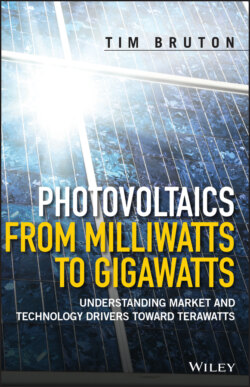Читать книгу Photovoltaics from Milliwatts to Gigawatts - Tim Bruton - Страница 20
1.3.3 Solar Cell Manufacturing
ОглавлениеBy 1972, there were a thousand satellites in space, with power requirements which varied from milliwatts for Vanguard 1 to kilowatts for Skylab A [55]. All the attendant solar cells had to be manufactured somewhere. Initially, Hoffman Semiconductor and Western Electric supplied some, but once the application had been established, new entrants rapidly appeared, not only in the United States but also in Germany and Japan.
One of the first start‐ups in the United States was Spectrolab in 1956, which initially manufactured optical filters and mirrors but in 1958 started in the space cell business, supplying a solar array to the Explorer 1 satellite and then another to Explorer 6 in 1959. Since then, it has supplied many satellites, including for Syncom, the first successful mission in a geosynchronous orbit. In 1993, the company installed equipment for the manufacture of III–V solar cells, signalling the move way from silicon in space. It currently offers cells of 30% efficiency. In 1975, Spectrolab was acquired by Hughes Aircraft, and in 2000 it became part of Boeing Corporation. It has produced over 4 MWp of space solar cells to date, and it continues in production [56]. At the same time, the Applied Solar Energy Corporation started manufacturing space cells and pioneered the deposition of GaAs cells on germanium substrates. ASEC became Tecstar Inc., but it entered chapter 11 bankruptcy in 2002 and its assets were acquired by Emcore Inc. COMSAT, as already described, started in 1962. In Germany, AEG‐Telefunken in Heilbronn started production of space solar cells, with the first supplied to the German AZUR1 satellite in 1968 [57]. The company still produces cells today, after many changes of ownership, under the name Azur Space Solar Power GmbH. It has provided cells for over 400 space projects. In Japan, the Sharp company started research into solar cells in 1959, and specifically addressed the space market from 1967 with the first deployment in space of the Ume satellite in 1976 [58]. Sharp continues today, making triple‐junction III–V cells for both space and concentrator solar cell applications.
While manufacture of space cells continues today, it is now a relatively small market compared to the terrestrial one. However, the expertise gained in manufacturing for space provided the basis for the growth of the terrestrial market following the 1973 oil crisis, as discussed in Chapter 2. By 1970, it had already been noted that growth prospects in the space cell industry were limited, and scientists were beginning to look to earth [39]. Sharp Corporation had consistently used reject space cells for terrestrial applications, supplying photovoltaic power to 256 lighthouses between 1961 and 1972 [59]. It demonstrated the first viable silicon module for terrestrial use in 1963 and became a major supplier of photovoltaic modules from 1980 onward. AEG‐Telefunken started terrestrial solar cell manufacture at its Wedel site in the mid‐1970s [57]. Other ‘pure’ terrestrial solar cell companies were founded by individuals leaving space cell companies. Bill Yerkes had been president at Spectrolab, but following the Hughes Aircraft acquisition he left the company to form Solar Technology International, which subsequently became ARCO Solar and was the largest photovoltaics manufacturer for several years [60]. Joseph Lindmayer and Peter Varadi left COMSAT in 1973 to form the Solarex company [61], and this too – after a merger with BP Solar – became the world’s largest photovoltaics manufacturer, in 2000 [61].
In this way, the development of solar cells for space formed the foundation of the major manufacturing industry and global energy supply that photovoltaics has become.
